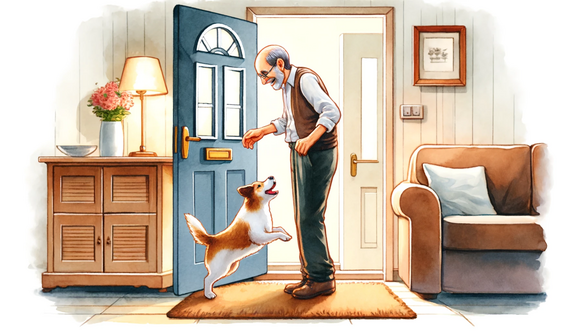Tail wagging in dogs: What your dog is really trying to tell you

Why do dogs wag their tails?
Tail wagging is one of the most well-known ways in which dogs communicate. But why do they actually do it? A dog's tail is an important part of their communication and is used to convey their emotions and intentions. Wagging can be triggered by a variety of factors, including happiness, excitement, nervousness, insecurity or even aggression. By observing the exact position and movement of the tail, you can get valuable clues about your dog's mood.
Different types of tail wagging and their meanings
Joy and excitement
When a dog is happy or excited, it often wags its tail vigorously and quickly. This is often accompanied by a relaxed posture and an open, friendly expression. The tail usually moves back and forth in a wide, loose motion. This type of tail wagging is often seen when you come home and your dog greets you.
Nervousness and insecurity
A dog that is insecure or nervous may also wag its tail, but the movement is often slower and the tail is set lower. This is often accompanied by a tense posture and other signs of stress such as ears laid back or a lowered head. It's important to pay attention to these subtle signs to reassure your dog in stressful situations.
Submissiveness and appeasement
Sometimes a dog will wag its tail to show submissiveness or appeasement. The tail is often tucked between the hind legs and the movements are small and uncertain. This can occur in situations where the dog feels threatened or is trying to avoid a confrontation.
Aggression and dominance
It may sound surprising, but an aggressive or dominant dog can also wag its tail. In these cases, however, the tail posture is high and stiff, and the movements are often slow and controlled. This is often accompanied by a rigid posture and direct eye contact. It is important to recognize this type of tail wagging to avoid potential conflict.
The importance of tail position
Not only the movement of the tail, but also its position provides information about your dog's mood. A high, erect tail often signals self-confidence and dominance, while a low or tucked tail shows signs of submissiveness or fear. A tail held horizontally can mean curiosity or neutral attention.
The role of breed in interpretation
It's important to note that the interpretation of tail wagging can also depend on your dog's breed. Dogs with shortened tails or breeds with natural curly tails have different body language than dogs with long, straight tails. Therefore, be sure to consider your dog's individual characteristics when interpreting their body language.
Tail wagging is a fascinating means of communication for your dog that can have many different meanings. By observing the exact movement, position and context of the tail wag, you can better understand your dog's mood and intent and build a deeper connection with them. Remember that your dog's body language should always be viewed in context to avoid misunderstandings. The better you can interpret your dog's signs, the more harmonious your relationship will be.